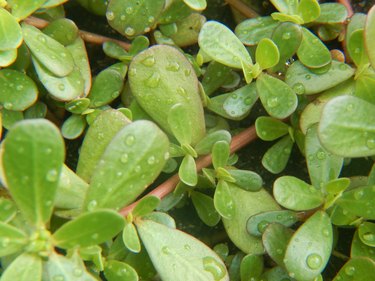
Purslane (Portulaca oleracea) is one of those love-it or hate-it weeds. To some gardeners it's an nuisance that invades lawns, garden borders and vegetable patches; to others it's free food. An annual plant that thrives in moist, warm conditions, purslane grows in dense mats of reddish stems up to 12 inches long and 1/2- to 2 1/2-inch-long oval, shiny, succulent leaves. Its yellow summer flowers are followed by seed pods filled with tiny, reddish-brown or black seeds.
Clean Green
Video of the Day
Purslane invades poorly maintained and newly sown lawns. Mow and water established lawns regularly to reduce purslane infestations. A broad-leaved herbicide, such as a ready-to-use spray containing 7.59 percent 2,4-D, 1.83 percent mecoprop and 0.84 percent dicamba, also provides control in new and mature lawns. Put on a long-sleeved shirt, long pants and gloves, and apply the herbicide on a dry, still day when purslane plants are actively growing.
Video of the Day
Pre-emergent herbicides kill weeds by preventing newly sprouted weeds from becoming established, not by preventing the seeds from actually sprouting. They should be applied just before soil temperatures rise to 60 degrees Fahrenheit. Apply a granular pre-emergent weedkiller containing 1.71 percent pendimethalin at a rate indicated on the product label Always check the label on the herbicide and follow the manufacturer's instructions, which can vary among different products. Herbicides usually provide effective control, but some purslane varieties are resistant to certain chemicals. Be sure to keep pets and children away from the area of application for at least three hours, as the ingredients can be toxic.
Border Control
Mulching is the most effective way to control purslane in garden borders. In established garden borders a 3-inch layer of organic mulch smothers purslane plants and prevents purslane seeds from sprouting. Spread garden compost, well-rotted manure, shredded bark, leaf mold or another organic material over the purslane plants, avoiding desired plants' stems, at any time of year. Top up the mulch when it thins out, and pull out any stray purslane plants that sprout on the surface. Alternatively, spread a layer of porous landscape fabric over the purslane plants and cover it with an inorganic mulch, such as gravel or pebbles.
Clear a Patch
Vegetable patches suffer badly from purslane infestations because they're constantly tilled. Digging a vegetable patch brings purslane seeds to the surface where they sprout and also breaks purslane roots into separate pieces, which grow into new plants. Hand-weeding provides some control, or you can leave your vegetable patch bare over summer and solarize the soil.
Dig a narrow trench 4 to 6 inches deep around the area to be solarized, and water the soil until it's moist to 12 inches deep. Place the edge of a sheet of transparent plastic 1 to 4 millimeters thick in the trench at one side of the area, and fill the trench with soil. Spread the sheet over the area and bury the edges in the trenches in the same way. Solarization controls most purslane plants and seeds in the top 12 to 18 inches in four to six weeks' of hot weather.
Constant Control
Purslane returns for many years and requires constant control. One purslane plant can produce 240,000 seeds, and seeds can sprout after five to 40 years in the soil. Allowing just a few plants to flower and set seed can result in a dense mat of purslane the following year. Pull out all purslane plants as they appear. Remove them when the soil is moist to avoid breaking their roots if possible. Clean equipment you've used in a purslane-infested areas thoroughly to reduce the risk of transporting plant parts or seeds to other parts of the garden, and don't hoe purslane plants because this increases their spread.